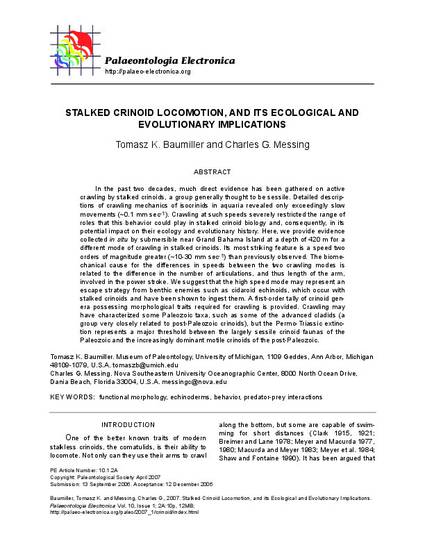
- Functional morphology,
- Echinoderms,
- Behavior,
- Predator-prey interactions
In the past two decades, much direct evidence has been gathered on active crawling by stalked crinoids, a group generally thought to be sessile. Detailed descriptions of crawling mechanics of isocrinids in aquaria revealed only exceedingly slow movements (~0.1 mm sec-1). Crawling at such speeds severely restricted the range of roles that this behavior could play in stalked crinoid biology and, consequently, in its potential impact on their ecology and evolutionary history. Here, we provide evidence collected in situ by submersible near Grand Bahama Island at a depth of 420 m for a different mode of crawling in stalked crinoids. Its most striking feature is a speed two orders of magnitude greater (~10-30 mm sec-1) than previously observed. The biomechanical cause for the differences in speeds between the two crawling modes is related to the difference in the number of articulations, and thus length of the arm, involved in the power stroke. We suggest that the high speed mode may represent an escape strategy from benthic enemies such as cidaroid echinoids, which occur with stalked crinoids and have been shown to ingest them. A first-order tally of crinoid genera possessing morphological traits required for crawling is provided. Crawling may have characterized some Paleozoic taxa, such as some of the advanced cladids (a group very closely related to post-Paleozoic crinoids), but the Permo-Triassic extinction represents a major threshold between the largely sessile crinoid faunas of the Paleozoic and the increasingly dominant motile crinoids of the post-Paleozoic.

Used with Permission from the Paleontological Society
NSF grant #s: EAR-9004232, EAR-9218467, EAR-9628215, EAR-9104892, EAR-9304789